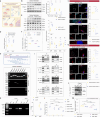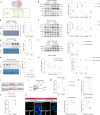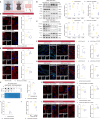N6-Methyladenosine-mediated phase separation suppresses NOTCH1 expression and promotes mitochondrial fission in diabetic cardiac fibrosis
- PMID: 39342271
- PMCID: PMC11439301
- DOI: 10.1186/s12933-024-02444-3
N6-Methyladenosine-mediated phase separation suppresses NOTCH1 expression and promotes mitochondrial fission in diabetic cardiac fibrosis
Abstract
Background: N6-methyladenosine (m6A) modification of messenger RNA (mRNA) is crucial for liquid-liquid phase separation in mammals. Increasing evidence indicates that liquid-liquid phase separation in proteins and RNAs affects diabetic cardiomyopathy. However, the molecular mechanism by which m6A-mediated phase separation regulates diabetic cardiac fibrosis remains elusive.
Methods: Leptin receptor-deficient mice (db/db), cardiac fibroblast-specific Notch1 conditional knockout (POSTN-Cre × Notch1flox/flox) mice, and Cre mice were used to induce diabetic cardiac fibrosis. Adeno-associated virus 9 carrying cardiac fibroblast-specific periostin (Postn) promoter-driven small hairpin RNA targeting Alkbh5, Ythdf2, or Notch1, and the phase separation inhibitor 1,6-hexanediol were administered to investigate their roles in diabetic cardiac fibrosis. Histological and biochemical analyses were performed to determine how Alkbh5 and Ythdf2 regulate Notch1 expression in diabetic cardiac fibrosis. NOTCH1 was reconstituted in ALKBH5- and YTHDF2-deficient cardiac fibroblasts and mouse hearts to study its effects on mitochondrial fission and diabetic cardiac fibrosis. Heart tissue samples from patients with diabetic cardiomyopathy were used to validate our findings.
Results: In mice with diabetic cardiac fibrosis, decreased Notch1 expression was accompanied by high m6A mRNA levels and mitochondrial fission. Fibroblast-specific deletion of Notch1 enhanced mitochondrial fission and cardiac fibroblast proliferation and induced diabetic cardiac fibrosis in mice. Notch1 downregulation was associated with Alkbh5-mediated m6A demethylation in the 3'UTR of Notch1 mRNA and elevated m6A mRNA levels. These elevated m6A levels in Notch1 mRNA markedly enhanced YTHDF2 phase separation, increased the recognition of m6A residues in Notch1 mRNA by YTHDF2, and induced Notch1 degradation. Conversely, epitranscriptomic downregulation rescues Notch1 expression, resulting in the opposite effects. Human heart tissues from patients with diabetic cardiomyopathy were used to validate the findings in mice with diabetic cardiac fibrosis.
Conclusions: We identified a novel epitranscriptomic mechanism by which m6A-mediated phase separation suppresses Notch1 expression, thereby promoting mitochondrial fission in diabetic cardiac fibrosis. Our findings provide new insights for the development of novel treatment approaches for patients with diabetic cardiac fibrosis.
Keywords: Diabetic cardiac fibrosis; Diabetic cardiomyopathy; Mitochondrial fission; Phase separation; RNA methylation.
© 2024. The Author(s).
Conflict of interest statement
The authors declare no competing interests.
Figures








References
-
- Du CX, Huang C, Lu Y, Spatz ES, Lipska KJ, Krumholz HM. Revisiting ACCORD: Should blood pressure targets in people with and without type 2 diabetes be different? Am J Med. 2023;136(1):6–8. - PubMed
Publication types
MeSH terms
Substances
Grants and funding
LinkOut - more resources
Full Text Sources
Medical
Miscellaneous

